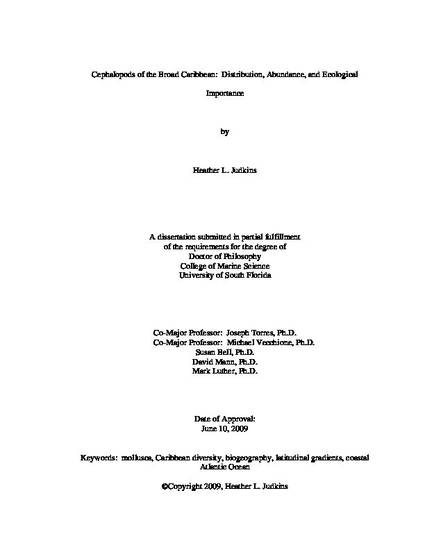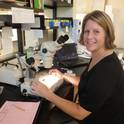
The Broad Caribbean region is defined as the Gulf of Mexico, and the coastal and marine areas of the Caribbean Sea, including the chain of islands forming the Greater and Lesser Antilles, Turks and Caicos, the Bahamas, and the gulf coasts of the United States, Central and South America (Stanley, 1995). The cephalopods of the Broad Caribbean were examined in terms of distribution, abundance, and ecological importance. A suite of 5190 preserved cephalopod specimens were identified and catalogued to produce regional maps of cephalopod distribution within the Broad Caribbean. Eighteen range extensions were noted for known species. Regional species richness was examined with respect to Rapoport's Rule with an eye toward possible cephalopod hotspots in the region. Cephalopods of the Broad Caribbean within the latitudinal bands of 8°N and 30°N do not support Rapoport's Rule as they exhibit increasing species richness with increasing latitude. Eight subareas were chosen to compare species richness. Regionally, species richness is patchy, with the largest concentration of cephalopods off the eastern Florida coast. Areas of the southern Caribbean Sea are in need of more samples for accurate assemblage counts and more meaningful comparisons with other Caribbean regions. Rarefaction curves were used to normalize the variously sized samples throughout the Broad Caribbean. A checklist of the Gulf of Mexico based on literature developed a picture for the northern regions of the Broad Caribbean. This checklist provided an updated account of cephalopod species that were reported from smaller literature works. Lastly, the first observation in the North Atlantic Ocean of the deep-sea squid Asperoteuthis acanthoderma (family Chiroteuthidae) was described. The description is based on two nearly intact, but damaged, specimens that were found floating at the surface in the waters off Key West and Marathon, Florida in 2007. All previously known records are recorded from a few specimens scattered in the western Pacific Ocean. There is a need for increased sampling throughout the Broad Caribbean to explore the systematics, life histories, distribution patterns, and potential fisheries for this group of organisms.

Full text document is available through the link provided.